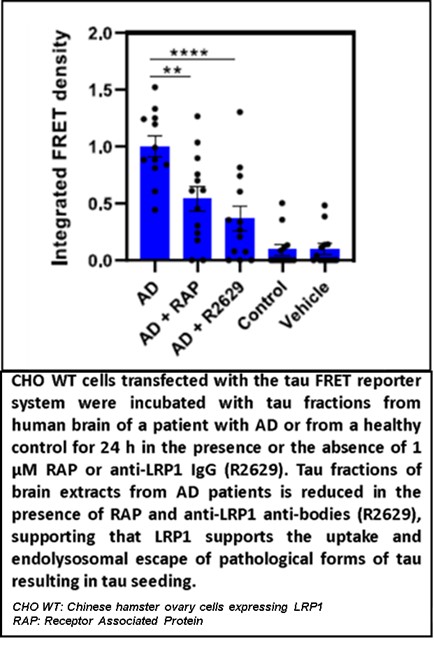Overview
Alzheimer’s disease (AD) is a neurodegenerative disease characterized by gradual deterioration of the brain cells and loss of multiple cognitive functions. The cognitive decline in AD is closely linked to aggregated forms of tau which form neurofibrillary tangles (“NFT”) that initiate in the entorhinal cortex and spread as the disease progresses. Such pathological forms of tau are transferred from cell to cell and “seed” aggregation of cytoplasmic tau. UMB investigators have identified low-density lipoprotein (LDL) receptor–related protein 1 (LRP1) as an endocytic receptor that binds and processes monomeric forms of tau leading to its degradation and promotes seeding of pathological forms of tau. The balance of these processes may be fundamental to the spread of neuropathology across the brain in AD. Evidence has shown that agents capable of blocking the interaction between tau and LRP1 could be beneficial for the treatment of AD.
Technology
LRP1 is an endocytic receptor that traffics ligands from the cell surface to endosomal compartments, where the ligands are typically sorted into lysosomal compartments and degraded. Furthermore, recent studies have provided evidence that LRP1 functions as an endocytic neuronal receptor for the uptake and spread of tau. UMB investigators discovered that the interaction of tau with LRP1 may be important for the progression of AD and have identified agents capable of blocking the interaction between tau and LRP1. This is supported by the demonstration that LRP1 expressing cells, but not those deficient in LRP1, promote the seeding of tau polymers isolated from human AD brains. Additionally, interaction of tau and LRP1 maybe influenced by post-translational modifications in tau since phosphorylated forms of tau bound much weaker to LRP1 than unphosphorylated tau forms. Results demonstrate that LRP1 efficiently mediates the delivery of tau to lysosomes, functioning to both degrade the tau ligand but also seed pathological forms of tau that exacerbate the progression of tau-mediated cognitive loss in AD. This present invention confirms that tau internalization in cells can be attenuated by LRP1 antagonists.

Applications
The global market for Alzheimer’s treatment was valued at $4.6 billion in 2019. The market is expected to grow at a compound annual growth rate (CAGR) of 5.5% to reach slightly over $6.3 billion by 2025. AD most commonly affects individuals 65 years old and over. As the older population grows due to increasing life expectancies, the number of people with AD is projected to double to 75 million by 2030. Currently, there is no definitive cure for AD. The few available therapies only alleviate the associated symptoms for a brief period of time, while failing to reverse or stop the progression of the disease. The need for effective treatments has become more urgent, especially given the recurrent failure of several prominent disease-modifying agents in late stage development.
Contact Info
Office of Technology Transfer
620 W Lexington St., 4th Floor
Baltimore, MD 21201
Email: [email protected]
Phone: (410) 706-2380